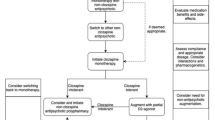Abstract
Purpose
The aim of this study was to investigate factors associated with the occurrence of extrapyramidal symptoms (EPS) in users of second-generation antipsychotics (SGA).
Methods
Observational cross-sectional study based on a random sample of subjects from three outpatient clinics. Inclusion criteria were age between 18 and 65 years, of both genders, with a diagnosis of schizophrenia and under the use of a single SGA agent. Subjects who had received i.m. long-acting antipsychotics in the past were excluded. The families of eligible patients were contacted by phone and, if willing to participate in the study, a household visit was scheduled. Informed consent was obtained from all study subjects and their next of kin. The risk of EPS associated with sociodemographic, clinical features and medications used was analyzed by logistic regression.
Results
The study population consisted of 213 subjects. EPS were observed in 38.0% of subjects. The more commonly used SGA were olanzapine (76, 35.7%), risperidone (74, 34.3%), quetiapine (26, 12.2%), and ziprasidone (23, 10.8%). Among the drugs used as adjunctive therapy for schizophrenia, benzodiazepines were the most prevalent (31.5%), followed by carbamazepine (24.4%) and antidepressants (20.2%). Multivariate analysis showed that the risk of EPS was associated with the use of carbamazepine (odds ratio 3.677, 95% CI 1.627–8.310). We found no evidence that the type of SGA modified the risk of EPS.
Conclusion
The occurrence of EPS in SGA users is a common finding, with no difference of antipsychotics studied in relation to the risk of extrapyramidal manifestations. The adjunctive use of carbamazepine may predispose the user of SGA to the occurrence of EPS.
Similar content being viewed by others
References
Gharaeipour M, Scott BJ (2012) Effects of cognitive remediation on neurocognitive functions and psychiatric symptoms in schizophrenia inpatients. Schizophr Res 142(1):165–170
Carpenter WT Jr, Buchanan RW (1994) Schizophrenia. N Engl J Med 330(10):681–690
Kalra G, Bhugra D, Shah N (2012) Cultural aspects of schizophrenia. Int Rev Psychiatry 24(5):441–449
van Os J, Kapur S (2009) Schizophrenia. Lancet 374(9690):635–645
Kane JM, Marder SR (1993) Psychopharmacologic treatment of schizophrenia. Schizophr Bull 19(2):287–302
Girgis RR, Phillips MR, Li X et al (2011) Clozapine v. chlorpromazine in treatment-naive, first-episode schizophrenia: 9-year outcomes of a randomised clinical trial. Br J Psychiatry 199(4):281–288
Kendall T (2011) The rise and fall of the atypical antipsychotics. BrJPsychiatry 199(4):266–268
Leucht S, Helfer B, Dold M, Kissling W, McGrath J (2014) Carbamazepine for schizophrenia. Cochrane Database Syst Ver 2(5):CD001258.
Harvey PD, Keefe RSE (2001) Studies of cognitive change in patients with schizophrenia following novel antipsychotic treatment. Am J Psychiatry 158(2):176–184
Tatara A, Shimizu S, Shin N et al (2012) Modulation of antipsychotic-induced extrapyramidal side effects by medications for mood disorders. Prog Neuro-Psychopharmacol Biol Psychiatry 38(2):252–259
Simpson GM, Angus JW (1970) A rating scale for extrapyramidal side effects. Acta Psychiatr Scand Suppl 212:11–19
Janno S, Holi MM, Tuisku K, Wahlbeck K (2005) Validity of Simpson-Angus Scale (SAS) in a naturalistic schizophrenia population. BMC Neurol 5(1):5
de Araújo AA, Ribeiro SB, dos Santos ACS et al (2015) Quality of life and hormonal, biochemical, and anthropometric profile between olanzapine and risperidone users. Psychiatr Q 87(2):293–304
Divac N, Prostran M, Jakovcevski I, Cerovac N (2014) Second-generation antipsychotics and extrapyramidal adverse effects. Biomed Res Int 2014:656370.
Leucht S, Davis JM, Engel RR et al (2009) Definitions of response and remission in schizophrenia: recommendations for their use and their presentation. Acta Psychiatr Scand 119(438):7–14
Weiden PJ (2007) EPS profiles: the atypical antipsychotics are not all the same. J Psychiatr Pract 13(1):13–24
Tsapakis EM, Dimopoulou T, Tarazi FI (2015) Clinical management of negative symptoms of schizophrenia: an update. Pharmacol Ther 153:135–147
Hakola HP, Laulumaa VA (1982) Carbamazepine in treatment of violent schizophrenics. Lancet 1:1358
Post RM (2004) Differing psychotropic profiles of the anticonvulsants in bipolar and other psychiatric disorders. Clin Neurosci Res 4(1–2):9–30
Simhandl C, Meszaros K, Denk E et al (1996) Adjunctive carbamazepine or lithium carbonate in therapy-resistant chronic schizophrenia. Can J Psychiatr 41(5):317
Neppe VM (1983) Carbamazepine as adjunctive treatment in nonepileptic chronic inpatients with EEG temporal lobe abnormalities. J Clin Psychiatry 44(9):326–331
Martin Munoz JC, Morinigo Dominguez AV, Mateo Martin I et al (1992) Carbamazepine: an efficient adjuvant treatment in schizophrenia. Actas Luso Esp Neurol Psiquiatr Cienc Afines 20(1):11–16
Hesslinger B, Normann C, Langosch JM et al (1999) Effects of carbamazepine and valproate on haloperidol plasma levels and on psychopathologic outcome in schizophrenic patients. J Clin Psychopharmacol 19(4):310–315
Zadikoff C, Munhoz RP, Asante a N et al (2007) Movement disorders in patients taking anticonvulsants. J Neurol Neurosurg Psychiatry 78(2):147–151
Author information
Authors and Affiliations
Corresponding author
Ethics declarations
The study was approved by the Ethics Committee for Research of the University Hospital Onofre Lopes under the number 207/09. The study complied with the Declaration of Helsinki of the World Medical Association. On the first visit after phone contact, all participants and the next of kin or caregiver signed an informed consent before any data was collected.
Conflict of interest
The authors declare that they have no conflict of interest.
Sources of funding
None.
Rights and permissions
About this article
Cite this article
Ribeiro, S.B., de Araújo, A.A., Medeiros, C.A.X. et al. Factors associated with expression of extrapyramidal symptoms in users of atypical antipsychotics. Eur J Clin Pharmacol 73, 351–355 (2017). https://doi.org/10.1007/s00228-016-2166-2
Received:
Accepted:
Published:
Issue Date:
DOI: https://doi.org/10.1007/s00228-016-2166-2




